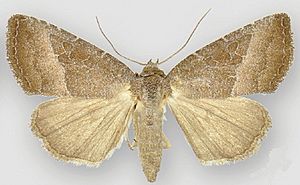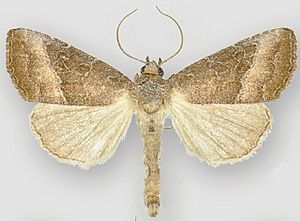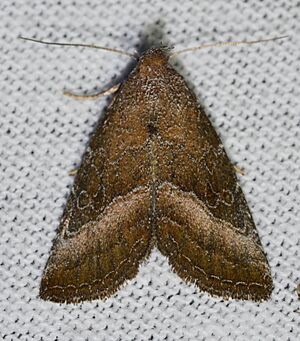Common pinkband moth facts for kids
Quick facts for kids Common pinkband moth |
|
|---|---|
 |
|
| Female | |
 |
|
| Male | |
| Scientific classification | |
| Synonyms | |
|
The common pinkband moth, known scientifically as Ogdoconta cinereola, is a type of moth. It belongs to the Noctuidae family, which includes many different kinds of moths.
This moth is found across a large area of North America. You can spot it in the eastern, central, and southwestern parts of the continent. Its range stretches from southern Ontario and Quebec in Canada, all the way south to Florida. In the west, it lives from Manitoba down through states like Nebraska and Iowa. It also lives throughout most of Texas and extends west into southern New Mexico and southeastern Arizona. You can even find it south of the border in Mexico, specifically in the state of Coahuila.
Contents
What Does the Common Pinkband Moth Look Like?
The common pinkband moth is quite small. Its front wings are usually between 9.5 and 14.5 millimeters long. These wings are a light brownish color. They have a special pinkish area near the outer edge, which gives the moth its name.
If you look closely, you might see tiny white speckles on the wings. There are also faint white lines and spots. These markings help to identify the moth. The back wings are mostly brown. Both male and female moths look very similar. However, the female's back wings are often a bit darker.
When Can You See These Moths?
Adult common pinkband moths are active during certain times of the year. In the northern parts of their habitat, they fly from May to September. If you are in warmer places like Texas or Florida, you might see them for a longer period, from April to October.
What Do Common Pinkband Moths Eat?
The young moths, called larvae (or caterpillars), have a varied diet. They enjoy eating plants from several different families. These include plants like Amaranthaceae (such as amaranth), Asteraceae (like ragweed, which is an Ambrosia species), Fabaceae (the pea family), Lamiaceae (the mint family), and Poaceae (the grass family).
Images for kids




